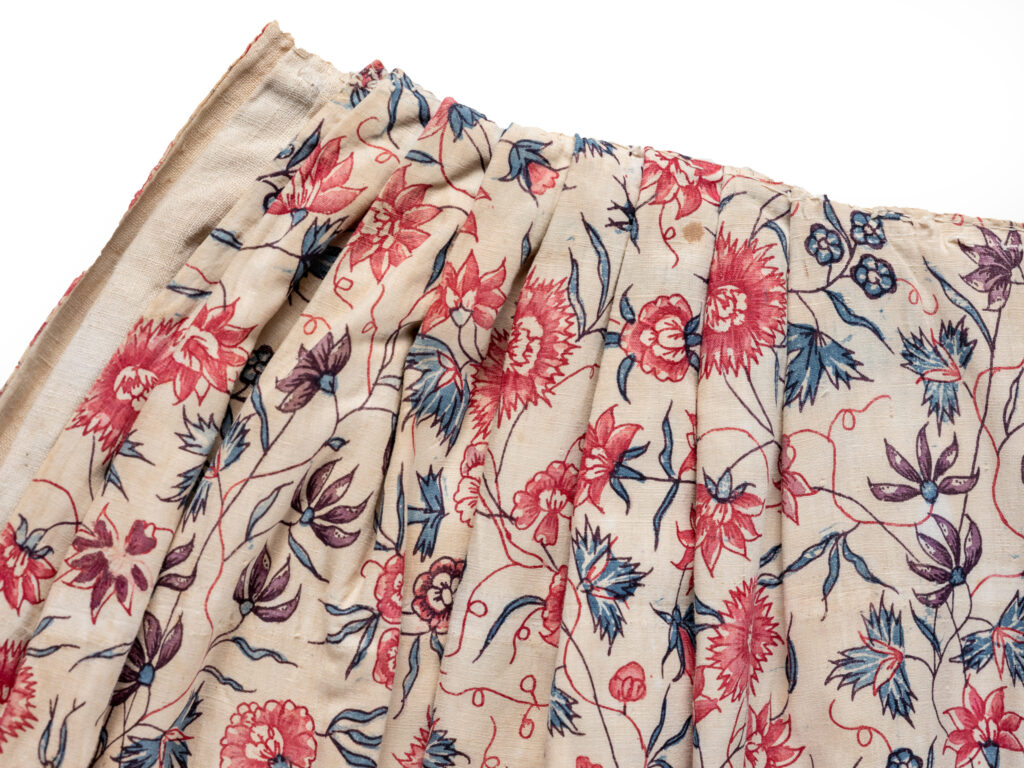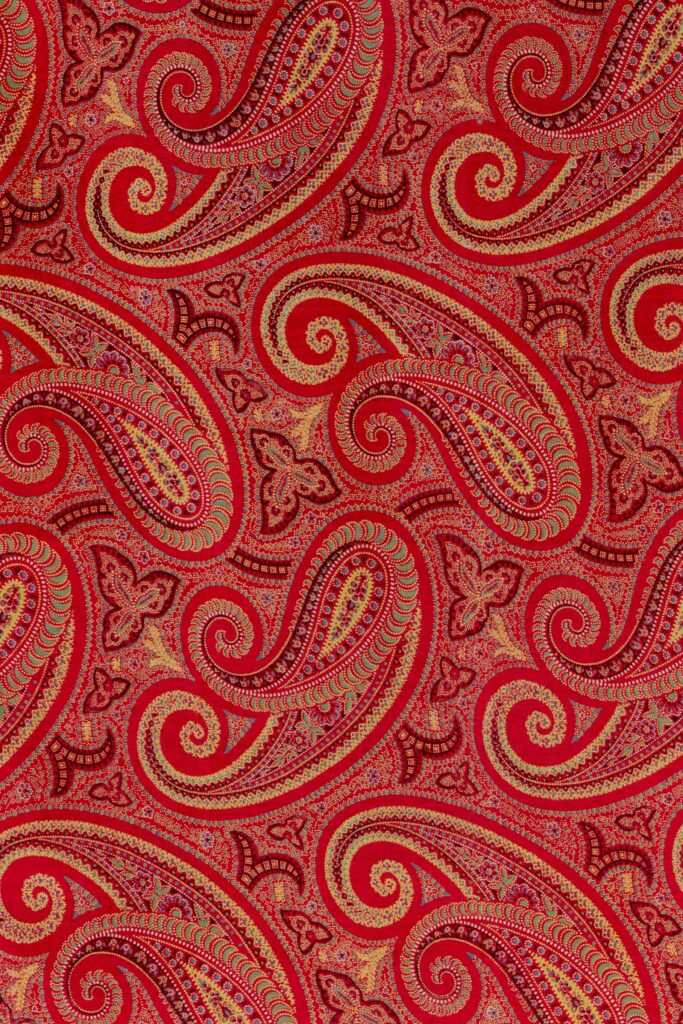Chamba Rumals
1
The Gawthorpe Textiles Collection contains around 500 textiles from the Indian Subcontinent and some of the rarest and finest examples are these two Chamba rumals. One depicts lavishly dressed riders on horseback while the other shows scenes from the life of Lord Krishna.
Chamba rumal embroideries take the first part of their name from the small town of Chamba in the Himachal Pradesh region of India and began being produced there in the 17th century. The region was famous for Pahari miniature painting and the influence of these paintings can be seen on the detailed designs and subject matter of the embroideries. The second part of their name; rumal, can be translated to handkerchief, covering or coverlet. The beautifully decorated cloths were used as gift wrappings or cloth coverings and for special occasions such as weddings.
To be able to share the story and significance of these two textiles in more detail Gawthorpe Textiles Collection have partnered with Dr Rohini Arora, an academic based in Himachal Pradesh, India and author of the book ‘Embroidered Narratives of Pahari Embroidery’. Rohini was able to analyze the designs and techniques used on the two rumals remotely using high resolution photographs.

Excerpts from her research, with accompanying images of the embroideries can be viewed below, or use these buttons to view full transcripts of her research.
Design Analysis of the Krishna Rumal Technique Analysis of the Krishna Rumal Technique Analysis of the Horse Riders Rumal“This is one of the spectacular examples of storytelling through embroidery… The rumal seeks inspiration from the story of Krishna’s birth, childhood, and youth narrated at great length and with much passion in Bhagvata Puran. The main characters seen in this rumal are Krishna, his parents and foster parents, his brother Balrama, his cowherd friends, king Kansa, Kansa’s father Ugarsena, demons, etc.”
Dr Rohini Arora
The Krishna rumal is worked in fine, untwisted silk floss thread on cotton muslin cloth. There are four divisions of the design, with each showing several scenes from Krishna’s life. The divisions are separated by a floral border in a style also seen on other examples of rumals.
The first division depicts four scenes, two relating to the beginning of the story and two telling the climax of the story. The division shows the birth of Lord Krishna and in the end, Krishna reinstalls his grandfather Ugarsena to the throne of Mathura after killing Kansa. It has been worked in two registers (horizontally) which show two scenes in each register. These scenes show divinities, human figures adorned with traditional costumes of Pahari region, architecture, a throne, weapons, and animals.
Dr Rohini Arora
- Birth of Krishna
- Exchange of babies
- Krishna meets his parents after killing Kansa
- Krishna reinstalls Ugrasena, his grandfather as king of Mathura.
The narrative begins with the birth of Krishna. Krishna belonged to the Yadava tribe, a pastoral people who lived in Vrindavana and Gokul (towns in Uttar Pradesh, India) on both sides of the river Yamuna. His parents, Devaki and Vasudeva were imprisoned by Kansa, the ruler of Mathura, for it had been prophesied that their child would kill him. Six of their children had already been killed by this evil king, and the seventh, Balrama, was miraculously transferred to the womb of Rohini, Vasudeva’s second wife. The eighth child of Devaki was Krishna, who was also saved by his father by exchanging him with a daughter born to Yashoda, wife of Nanda, who lived in Gokul, across the Yamuna.
Dr Rohini Arora
This scene shows Krishna’s father, Vasudeva, taking his newborn son to be exchanged with the baby girl of Nanda and Yashoda to save him from Kansa’s wrath. During the journey the cobra-like seprent Sesha shelters the baby Krishna from the rain using his hood. The tiger seen on the right is a representation of the goddess Durga. The stitch technique on the tiger is a good example of how the embroiderer has used different stitch directions to create contrasting textures in the tiger’s fur.
This division depicts five scenes in two registers, three on the upper and two in the lower registers. Here he is killing demons like Putana, Sakatasura, and Bakasura, as well as some episodes from his early childhood years. These scenes show human figures adorned with traditional costumes of Pahari region, architecture, and a variety of local musical instruments of the region.
Dr Rohini Arora
- Yashoda receives Krishna.
- Killing of demoness Putana
- Killing of Sakatasura
- Krishna’s birth celebration
- Killing of demon Bakasura
Below the second division is the third one (left to right), which shows the six activities of Lord Krishna, three scenes in each register (upper and lower). It shows Krishna’s killing of various demons in his later childhood years, which came in the form of animals such as a bull, horse, elephant, python, etc.
Dr Rohini Arora
- Killing of demon bull Arishtasura
- Killing of demon horse Keshi
- Krishna killing elephant Kuvalayapida.
- Krishna is tied to the mortar.
- Killing of demon python Aghasura
- Krishna playing with brother and gopas.
The Bhagvata Puran states that a demon Aghasura assumed the form of an enormous serpent to kill Krishna. The demon assumed the gigantic body of a boa constrictor, stout like a big mountain, motionless, and his tongue like a broad road. Krishna’s companions, the cowherd boys, entered its mouth, mistaking it for a mountain cavern. After seeing this, Krishna then came to their rescue, entered his mouth and killed demon Aghasura, and saved his friends, cows, etc. The boys and the cattle are reappearing through the wounds or an opening in the belly of the monster. The monster’s body is shown spotted while Krishna and Balrama are in their usual costumes.
Dr Rohini Arora
Fourth and last division of rumal shows seven scenes of Krishna’s life, where he and his brother went to Mathura and killed Kansa and other demons, which have been arranged in three registers. The scene shows the festivity, the killing of a demon, a musical instrument, a throne and colourful courtly costumes.
Dr Rohini Arora
- Krishna and Balarama meet the dyer.
- Two wrestlers.
- Krishna killing Kansa.
- Krishna and the hunchback.
- Krishna killed the Chanur.
- Balarama killing Sunama.
- Krishna killing Kuvalayapida
This rumal is also designed in four divisions but rather than each division showing multiple scenes each contains one large and detailed depiction of a rider on horseback. The horses are shown in leaping or running poses while the riders are shown with one arm raised and holding various tools or weapons. Hunting scenes were a popular design for rumals, so it is possible that this is the activity the riders are engaged in.
Between each division and around the outside is another floral border, quite similar in style to the one seen on the Krishna rumal.
This close-up shows the beautifully even stitching seen on the rumal, which is worked in long and short stitch. Both vertical and horizontal stitch directions have been used, which gives additional variety to the texture of the embroidery.
This image shows the reverse of the work, which highlights how skilfully the stitching is worked, as there is no real difference between the front and back of the embroidery. This includes no visible knots where the threads have been started or finished.
Here we see another of the riders holding what might be a bow. The clothing of each riders is well observed and uses striped patterns for some of the fabrics depicted. these decorative details and the style of the garments indicate the riders wealth and potentially royal status.
To the far right side of this image a row of dark zig zag stitches can be seen, which are used to secure the metal tape edging. This is the only noticeable different between the front and back with the metal tape appearing on the front and the stitching securing it visible on the reverse.
It is also possible to see some traces of the original drawn outlines for the design where the black silk stitched outlines have worn away.
In this image the metal tape used to edge the rumal can be seen. Although now very frail and tarnished it must have been a beautifully shimmering finishing touch when new. It is made from thin metal strips woven with red threads to form a fine tape.
Related

Cloth Cultures - Cotton
Fashion Historian Amber Butchart curates an exhibition exploring movement, migration and making using pieces found in the Gawthorpe Textiles Collection.
View item
Turkey Red & Khaki at Elmfield Hall
Exploring the connections between two iconic dyes and the story of William Gatty and his home; Elmfield Hall in Accrington.
View item


















Comments
(0 comments)
There are no comments available for this exhibition.
Leave a comment
You must be logged in to post a comment.